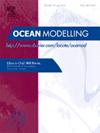北大西洋次极地的区域NEMO 4.0配置
IF 3.1
3区 地球科学
Q2 METEOROLOGY & ATMOSPHERIC SCIENCES
引用次数: 0
摘要
北大西洋次极环流(SPG)的动力在很大程度上控制着大西洋经向翻转环流(AMOC),从而影响全球海洋的长期气候变率。北大西洋SPG的许多关键过程,如墨西哥湾流分离、涡旋活动、深对流和溢流,在现代海洋环流模式中经常被错误地描述或歪曲。本文提出了一种基于NEMO4结构的北大西洋次极涡旋解析新模式,并分析了该模式能否充分反映北大西洋次极涡旋动力学。使用现场数据(横断面水文、Argo和海洋滑翔机)、遥感数据(卫星海面温度和盐度)以及基于最佳插值产品的ANDRO和ARMOR3D产品来评估模型的性能。在接下来的步骤中,我们分析了海洋建模中几个最新发展的影响,以改进模型解决方案。采用附加粘度的自扩散动量平流方案,可以模拟更真实的深西部边界流和伊明格环的生命周期特征。在强迫函数中实现的表面流反馈参数化和对上层海洋,特别是强烈涡旋区域动能收支的修正,模拟了耦合模式预测的行为。虽然模型对冷暖层参数化的实现很敏感,但与观测数据相比,这种参数化并没有显著改善解。在级联区域实施局部-西格玛垂直坐标系,可以使溢出水更真实地在海底蔓延。在伊尔明格海和冰岛盆地西坡的垂直温盐构造以及拉布拉多海的深西边界流中,追踪了局部-西格玛坐标实施的远程效应。与z偏步长设置相比,local-sigma允许正确表示AMOC翻转部分和北大西洋深水地层中水的连续致密化。讨论了新模式配置分析北大西洋次极区包括对流活动的潜力。本文章由计算机程序翻译,如有差异,请以英文原文为准。
A regional NEMO 4.0 configuration of the subpolar North Atlantic
The dynamics of the North Atlantic subpolar gyre (SPG) largely control the Atlantic Meridional Overturning Circulation (AMOC), thus affecting the long-term climate variability of the global ocean. Many key processes in the North Atlantic SPG, such as Gulf Stream detachment, eddy activity, deep convection and overflows, are frequently incorrectly presented or misrepresented in modern ocean general circulation models. Here, we demonstrate a new regional eddy-resolving model of the subpolar North Atlantic based on the NEMO4 configuration and analyze its ability to adequately represent the dynamics of the subpolar North Atlantic. The model performance is assessed using in situ data (cross-section hydrography, Argo and sea gliders), remote sensing data (satellite sea surface temperature and salinity) and the ANDRO and ARMOR3D products based on optimal interpolation products. In the next step, we analyze the effects of several recent developments in ocean modeling to improve the model solution. The implementation of the self-diffusive momentum advection scheme with additional viscosity allows for the simulation of more realistic Deep Western Boundary Current and Irminger Rings lifecycle characteristics. The surface current feedback parameterization implemented in the forcing function and the modification of the kinetic energy budget in the upper ocean, especially in intensively eddying areas, simulate the behavior predicted by coupled models. While the model is sensitive to the implementation of cool skin–warm layer parameterization, this parameterization does not significantly improve the solution compared to the observational data. Regional implementation of the local-sigma vertical coordinate system in cascading areas allows overflow waters to spread over the ocean bottom more realistically. The remote effect of the implementation of the local-sigma coordinate is traced in the vertical thermohaline structure at the western slopes of the Irminger Sea and Iceland Basin as well as in the Deep Western Boundary Current in the Labrador Sea. Compared to z-partial step setting, local-sigma allows for correct representation of continuous densification of the water in the overturning part of the AMOC and thus North Atlantic Deep Water formation. The potential of the new model configuration for analyzing the subpolar North Atlantic, including convective activity, is discussed.
求助全文
通过发布文献求助,成功后即可免费获取论文全文。
去求助
来源期刊

Ocean Modelling
地学-海洋学
CiteScore
5.50
自引率
9.40%
发文量
86
审稿时长
19.6 weeks
期刊介绍:
The main objective of Ocean Modelling is to provide rapid communication between those interested in ocean modelling, whether through direct observation, or through analytical, numerical or laboratory models, and including interactions between physical and biogeochemical or biological phenomena. Because of the intimate links between ocean and atmosphere, involvement of scientists interested in influences of either medium on the other is welcome. The journal has a wide scope and includes ocean-atmosphere interaction in various forms as well as pure ocean results. In addition to primary peer-reviewed papers, the journal provides review papers, preliminary communications, and discussions.
 求助内容:
求助内容: 应助结果提醒方式:
应助结果提醒方式:


